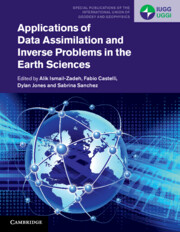Book contents
- Applications of Data Assimilation and Inverse Problems in the Earth Sciences
- Series page
- Applications of Data Assimilation and Inverse Problems in the Earth Sciences
- Copyright page
- Contents
- Contributors
- Preface
- Acknowledgements
- Part I Introduction
- Part II ‘Fluid’ Earth Applications: From the Surface to the Space
- Part III ‘Solid’ Earth Applications: From the Surface to the Core
- 11 Trans-Dimensional Markov Chain Monte Carlo Methods Applied to Geochronology and Thermochronology
- 12 Inverse Problems in Lava Dynamics
- 13 Data Assimilation for Real-Time Shake-Mapping and Prediction of Ground Shaking in Earthquake Early Warning
- 14 Global Seismic Tomography Using Time Domain Waveform Inversion
- 15 Solving Larger Seismic Inverse Problems with Smarter Methods
- 16 Joint and Constrained Inversion as Hypothesis Testing Tools
- 17 Crustal Structure and Moho Depth in the Tibetan Plateau from Inverse Modelling of Gravity Data
- 18 Geodetic Inversions and Applications in Geodynamics
- 19 Data Assimilation in Geodynamics: Methods and Applications
- 20 Geodynamic Data Assimilation: Techniques and Observables to Construct and Constrain Time-Dependent Earth Models
- 21 Understanding and Predicting Geomagnetic Secular Variation via Data Assimilation
- 22 Pointwise and Spectral Observations in Geomagnetic Data Assimilation: The Importance of Localization
- Index
- References
22 - Pointwise and Spectral Observations in Geomagnetic Data Assimilation: The Importance of Localization
from Part III - ‘Solid’ Earth Applications: From the Surface to the Core
Published online by Cambridge University Press: 20 June 2023
- Applications of Data Assimilation and Inverse Problems in the Earth Sciences
- Series page
- Applications of Data Assimilation and Inverse Problems in the Earth Sciences
- Copyright page
- Contents
- Contributors
- Preface
- Acknowledgements
- Part I Introduction
- Part II ‘Fluid’ Earth Applications: From the Surface to the Space
- Part III ‘Solid’ Earth Applications: From the Surface to the Core
- 11 Trans-Dimensional Markov Chain Monte Carlo Methods Applied to Geochronology and Thermochronology
- 12 Inverse Problems in Lava Dynamics
- 13 Data Assimilation for Real-Time Shake-Mapping and Prediction of Ground Shaking in Earthquake Early Warning
- 14 Global Seismic Tomography Using Time Domain Waveform Inversion
- 15 Solving Larger Seismic Inverse Problems with Smarter Methods
- 16 Joint and Constrained Inversion as Hypothesis Testing Tools
- 17 Crustal Structure and Moho Depth in the Tibetan Plateau from Inverse Modelling of Gravity Data
- 18 Geodetic Inversions and Applications in Geodynamics
- 19 Data Assimilation in Geodynamics: Methods and Applications
- 20 Geodynamic Data Assimilation: Techniques and Observables to Construct and Constrain Time-Dependent Earth Models
- 21 Understanding and Predicting Geomagnetic Secular Variation via Data Assimilation
- 22 Pointwise and Spectral Observations in Geomagnetic Data Assimilation: The Importance of Localization
- Index
- References
Summary
Abstract: Geomagnetic data assimilation aims at constraining the state of the geodynamo working at the Earth’s deep interior by sparse magnetic observations at and above the Earth’s surface. Due to difficulty separating the different magnetic field sources in the observations, spectral models of the geomagnetic field are generally used as inputs for data assimilation. However, the assimilation of raw pointwise observations can be relevant within certain configurations, specifically with paleomagnetic and historical geomagnetic data. Covariance localisation, which is a key ingredient to the assimilation performance in an ensemble framework, is relatively unexplored, and differs with respect to spectral and pointwise observations. This chapter introduces the main characteristics of geomagnetic data and magnetic field models, and explores the role of model and observation covariances and localisation in typical assimilation set-ups, focusing on the use of 3D dynamo simulations as the background model.
Keywords
- Type
- Chapter
- Information
- Publisher: Cambridge University PressPrint publication year: 2023



